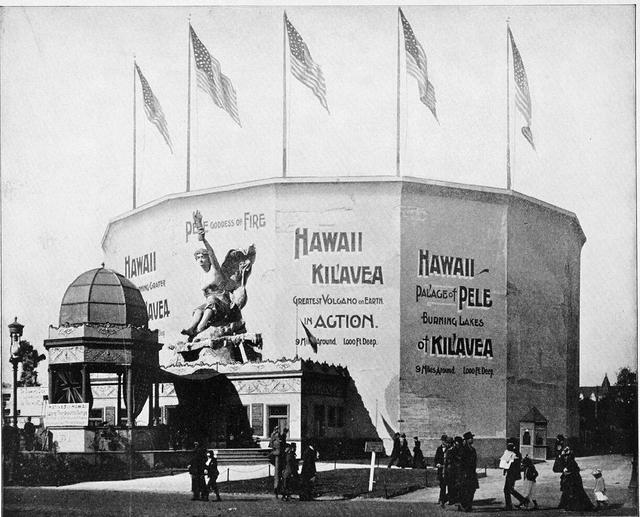The simulation of real and imaginary worlds for video games, movies, and other purposes has become big business in the 21st century. Virtual reality technology is improving rapidly, but the basic concept is not new. ADVERTISING The simulation of real
The simulation of real and imaginary worlds for video games, movies, and other purposes has become big business in the 21st century. Virtual reality technology is improving rapidly, but the basic concept is not new.
In the late 19th century, several artists were perfecting the portrayal of the fiery hues and breathtaking spattering of Kilauea’s lava lake. The most prominent of these painters was Jules Tavernier, who was trained in France and already well known in California before he moved to Hawaii in 1884. Inspired by the active lava lake within Kilauea Crater, Tavernier created several paintings of various sizes that have remained iconic views of the lava lake’s activity during that period.
In 1888, Tavernier went one step further and created what we would now call a virtual reality depiction of Kilauea volcano— the “Panorama of Kilauea,” an 11-foot canvas arranged in a circle with a 90-foot circumference.
The Daily Bulletin (a Honolulu newspaper) described the viewer’s experience: “On reaching the platform [at the center surrounded by the canvas] from which the visitor gazes, the scene becomes impressive. Standing in the very center of the crater, with Halemaumau … and the Volcano House in their proper positions they appear as realistic as can be. The longer the visitor gazes, the stronger becomes the impression, until he fancies that he is actually in Kilauea.”
The Panorama of Kilauea was exhibited in the Hawaiian Kingdom for a while before being shipped to the United States. It eventually ended up in Washington, D.C., for public exhibition. Unfortunately, neither this valuable canvas nor any photos of it have ever been found.
A few years later, Lorrin A. Thurston, a rising political leader of American missionary descendants and expatriates in the Hawaiian Kingdom, was looking for ways to accelerate tourism and to encourage Americans to settle in Hawaii. He proposed a Hawaii exhibit at the Chicago World’s Fair to open in 1893.
After the success of Tavernier’s Panorama of Kilauea, Thurston thought that a larger cyclorama of Kilauea “could be used advantageously to advertise Hawaii.” Thurston’s cyclorama was 50 feet high with a circumference of 400 feet—more than four times the size of Tavernier’s panorama.
The Chicago Times newspaper described the cyclorama viewer’s experience: “The observation platform … places the visitor in the same position that he would occupy if he stood on the brink of the [Halemaumau] pit in the vast crater of the volcano [Kilauea]. … The horizon will present the outlines of … [Mauna Loa’s] snow-capped summit, from which issue delicate clouds of smoke, telling of the slumbering fires beneath her crest. Further along the eye meets Mauna Kea, the volcano house, and the blue sea. In the middle distance is the ragged side walls of the first great breakdown, seamed and furrowed with cracks and jagged edges, where the rocks have been rent by many an earthquake. Beneath his foot will be the lakes of fire, liquid lava, foaming, dashing, leaping in the wildest confusion. The floor will be a facsimile of the floor of the crater in every detail, built up of lava, and the fire effects secured by the use of electricity in the most ingenious and complicated contrivances. The observer will stand on lava rock brought from Kilauea.”
The Kilauea cyclorama, accompanied by agricultural exhibits and a Hawaiian village, including musicians and hula dancers, was later exhibited at the San Francisco Midwinter Fair in 1894-1895, and at several more mainland expositions into the early 20th century.
It is unknown how effective these exhibits were at attracting American visitors to Hawaii, but Thurston’s cyclorama certainly provided an inexpensive way for thousands to experience Kilauea Volcano.
Volcano Watch is a weekly article and activity update written by U.S. Geological Survey Hawaiian Volcano Observatory scientists.
Volcano Activity Updates
Kilauea continues to erupt at its summit and East Rift Zone. This past week, the summit lava lake level varied between about 43-108 feet)below the vent rim. The 61g lava flow was still active and entering the ocean near Kamokuna. A younger branch of the flow is advancing slowly to the east of Puu Oo. The 61g lava flows do not pose an immediate threat to nearby communities.
Mauna Loa is not erupting. During the past week only 10 earthquakes were located, all less than magnitude-1.5, primarily in the upper Southwest Rift Zone and summit area at depths less than 3 miles. Global Positioning System (GPS) measurements continued to show deformation related to inflation of a magma reservoir beneath the summit and upper Southwest Rift Zone.
Four earthquakes were reported felt on Hawaii Island during the past week. At 10:49 a.m. Dec. 19, a magnitude-2.9 earthquake occurred 3.2 miles southeast of Kilauea’s summit at a depth of 1.8 miles. At 6:30 a.m. Dec. 18, a magnitude-4.5 earthquake occurred 36.4 miles south of Ka Lae (South Point) at a depth of 22.7 miles. At :42 a.m. on Dec. 17, a magnitude-3.6 earthquake occurred 12.8 7.9 miles southeast of Kilauea’s summit at a depth of 5 miles. At 8:45 a.m. on Dec. 16, a magnitude-3.8 earthquake occurred 8.2 miles southeast of Kilauea’s summit at a depth of 5 miles.
Visit https://hvo.wr.usgs.gov for past Volcano Watch articles, Kilauea daily eruption updates, Mauna Loa weekly updates, volcano photos, recent earthquakes info, and more; call for summary updates at 967-8862 (Kilauea) or 967-8866 (Mauna Loa); email questions to askHVO@usgs.gov.
Volcano Watch is a weekly article and activity update written by U.S. Geological Survey Hawaiian Volcano Observatory scientists.



